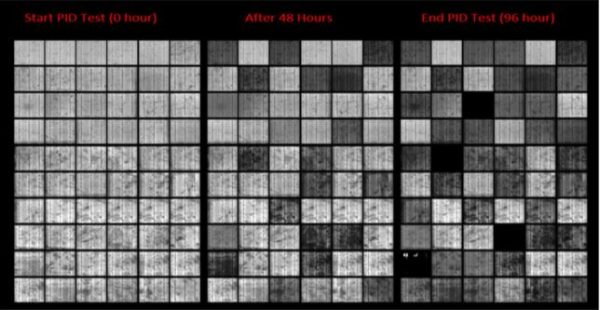Researchers from the University of York have conducted a standard test on the multiple effects of potential-induced degradation (PID) on the thermal and electrical performance of PV modules.
“For many PV systems, PID is one of the leading causes of module degradation caused by the high voltage between the encapsulants and the front glass surface, which is grounded via the substructure of the cell or the frame,” they explained in the study Power loss and hotspot analysis for photovoltaic modules affected by potential induced degradation, published in npj materials degradation. “PID becomes more prevailing as the module ages, and whilst it normally does not affect all the solar cells in the module, it does have a critical impact as it cannot be repaired.”
The novel approach considered all multiple PID effects through a comprehensive analysis, which included power losses, hotspots, mm-level defects, and the performance ratio (PR) of 28 modules affected by PID at an outdoor testing field.

Image: University of York, npj materials degradation, Creative Commons License CC BY 4.0, https://bit.ly/3HgkG09
Through the test, the scientists ascertained that power losses caused by PID may be significant. “For example, if a PV module has around 8% power losses at the initial state of the PID test, the power losses would likely be in the range of 30% and 50% after 96 h,” they specified. “This plot gives an indication of the PID impact over time.”
Electroluminescence images were taken during the experiment to estimate power losses and they showed that only a few solar cells were unaffected, with their output power losses not exceeding 5%. “This suggests that these cells were influenced by lower shading rates, heat, humidity, or any form of cracks during their working life,” the scientists emphasized.
After 96 h, the PV module had 30 hotspots and four panels saw their temperature increase significantly by up to 40 degrees Celsius, with four panels being affected by a significant increase in the temperature to 45 °C.

Image: University of York, npj materials degradation, Creative Commons License CC BY 4.0, https://bit.ly/3HgkG09
Their analysis also showed that the power losses of the PV modules at irradiance levels between 50 and 200 W/m2 are up to four times higher than at 1000 W/m2 and that solar cells attacked by PID can develop hotspots, increasing the temperature of the cells from 25 to 45 degrees Celsius. The average performance ratio of the tested modules at the end of the PID experiment was 71.16%.
“Following the IEC61215 standard we found 60% of the examined PV modules failed the reliability test after completing the PID experiment,” the academics concluded. “In addition, on a mm-level, we have discovered that PID can impact the solar cells with different damages, such as discontinuation of the cells fingers and busbars.”
This content is protected by copyright and may not be reused. If you want to cooperate with us and would like to reuse some of our content, please contact: editors@pv-magazine.com.




Important research & another reason why the 2nd hand market needs to be critically appraised, and where necessary, standards or regulations developed. (also increasingly referred to as “circular” or “2nd life” in some circles 😉